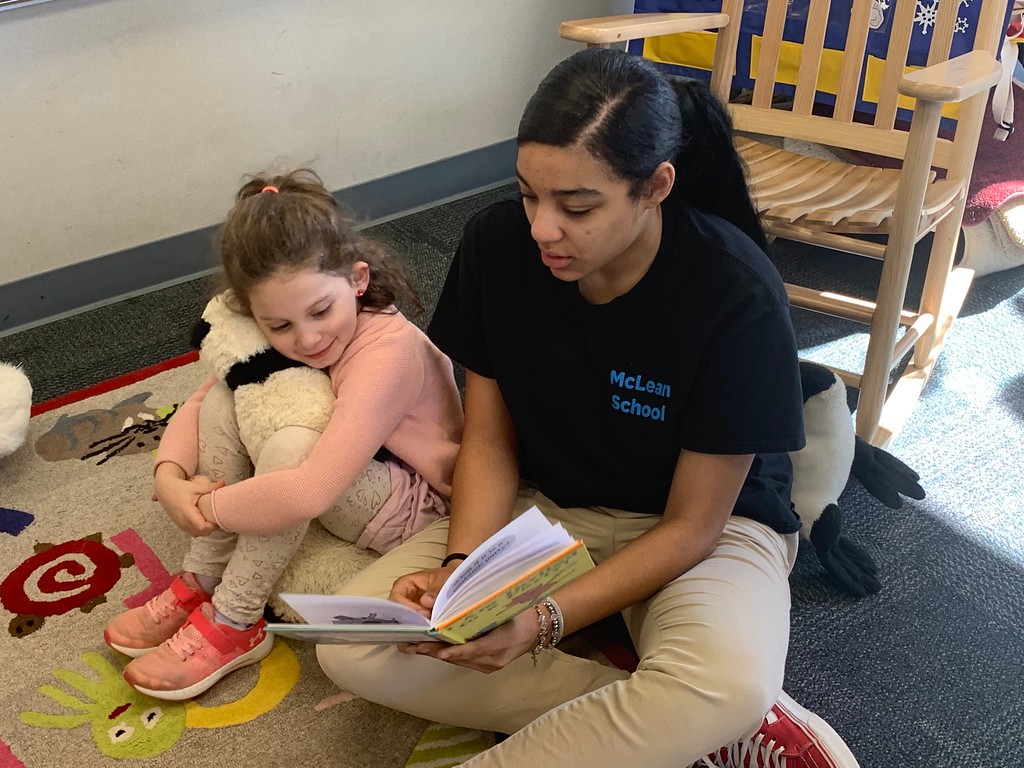Abby Himmelrich, Lower School Reading Specialist
Structured vs. Balanced Literacy: Why It Matters When Learning to Decode

What are we doing when we teach students to read? Most schools take what is known as a Balanced Literacy approach, which aims to teach students to read by surrounding students with books and responding to areas of challenge by relying heavily on context and visual cues to make connections.
But we know from research that reading isn’t a visual task. Yes, you see the word on the page, but it is in fact a phonological processing task, where a person’s brain automatically decodes the sound at first sight. For this to work, however, the brain has to know the code of the English language to begin with–and that’s where Structured Literacy comes in.
What is Structured Literacy?
Structured Literacy is a sequential, direct way of teaching reading, and it’s what we do here at McLean School: explicit instruction rooted in phonology, sound-symbol knowledge (orthography), morphology, syntax, and semantics. These are the building blocks of reading that create a necessary foundation for fluency, comprehension, vocabulary, spelling, and writing.
For years, teachers and parents have shared the mentality that if you acquaint early readers with different types of texts and experiences, they will learn to read. And there is, of course, value in having exposure to lots of books because that’s how we build our base of knowledge and understanding–but it won’t teach a struggling reader to decode. What it will do is encourage guesswork and an incidental, reactive (versus Structured Literacy’s proactive) approach. So for example, a child will learn that “celery” has a soft “c”, but this may not be revisited until they read “city” as “kitty” later on. This incidental phonics-based response is the hallmark of Balanced Literacy, versus intentionally teaching decoding as a skill through Structured Literacy. Or as I often think about it, Structured Literacy is “bottom up”–starting with the most basic elements of individual sounds and letters and building on those before moving to meaning–and Balanced Literacy is “top down”–starting with whole words and relying on context and cues to break them apart.
Here’s the key: Balanced Literacy works for some children, and many are able to learn to read without the explicit instruction. But Structured Literacy works for all children, and is in fact essential for many.
Orton Gillingham (OG) is a multisensory approach to reading instruction that has become the gold standard among specialists, including all of the Lower School educators at McLean. The OG approach is centered on phonics, which is just one part of the Structured Literacy approach; the other has to do with comprehension and language development. When we focus on the sub-skills of reading, we are able to increase fluency, and when we increase fluency, it frees us up to see the forest for the trees.
As mentioned, this structured approach serves all learners well, even those for whom reading comes naturally, and even the most voracious readers in our classrooms. In my own experiences I’ve found elements of Structured Literacy also benefit students who do not have a diagnosed reading disability, such as dyslexia, but may struggle with impulsivity or inattention. These students often end up doing a lot of guesswork while reading because it is harder to slow down and decode or comprehend carefully. These are the children who end up missing out on important learning. And yet, when given a reading assessment, these students often can muddle through and pass as proficient. In our classrooms, however, “good enough” isn’t good enough, and certainly isn’t a strong enough foundation for the more advanced expectations of the upper grades, college, and beyond. The explicit instruction that Structured Literacy provides builds efficient neural pathways in the brain and is therefore a much more sustainable, successful approach.
Another major differentiator between Balanced and Structured Literacy has to do with reading levels and moving students along as readers. Structured Literacy uses assessments to drive instruction and groups them based on their skill gaps (and strengths) in both phonics and comprehension skills as opposed to a more arbitrary grouping by “levels” in Balanced Literacy.
These levels are somewhat arbitrary–based on length of book, illustrations, content and theme, words, and more. In Balanced Literacy a student with high comprehension but weak decoding skills could be assigned a certain “level” that has nothing to do with their true ability to decode words. And speaking of decoding words, what if you come across a word you don’t know? Balanced Literacy encourages readers to look at the picture for clues, or skip the word altogether with the hope of circling back to it at some point because it will all make sense eventually. And for some, that’s true.
But what about the rest of the children? This is the question that drives all that we do at McLean to support all students. Students who deserve to be defined by their strengths rather than their challenges, in reading or otherwise. When we even out the playing field with programs and pedagogies like Structured Literacy that make no assumptions but, rather, rely on brain research and proven practices, we are able to give students the tools to become successful and independent readers.